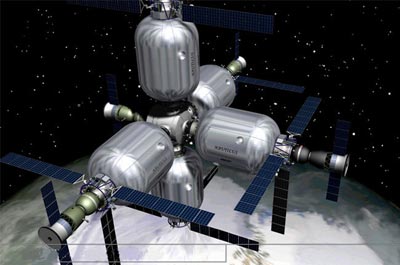2004: So far, what a great yearby Taylor Dinerman
|
| The real action in 2004, though, has been in the private sector. |
Yet, there is a feeling of great things happening. The new Vision for Space Exploration has, at last, given NASA and the rest of the government a clear direction and a set of goals that are realistic, both politically and technologically. The Cassini/Huygens mission successfully entered into orbit around Saturn. On Mars, the rovers continue to operate long after most experts expected them to fail. NASA’s X-43A showed that the agency can actually run a hypersonic research program that does not inevitably blow up.
The real action in 2004, though, has been in the private sector. Bigelow’s space hotel project is moving forward and shows at least as much credibility as many government programs. Indeed, the TransHab technology on which the inflatable modules are based is probably going to be an important part of the next generation space vehicles and habitats. The fact that they are planning to test a one-third scale model in orbit, launched on one of Elon Musk’s Falcons, shows just how serious this project really is.
The Ansari X Prize competition is the biggest space news of the year, even if it does not involve actually getting into orbit. From the moment SpaceShipOne took its first powered flight in December of last year, Rutan’s team was the favorite to win the X Prize. Not only were they better funded, but the Scaled Composites workforce that Rutan has put together had more experience building structures for suborbital reusable rockets than all the other teams put together. While the work they did on the DC-X aeroshell may not have been directly applicable to SpaceShipOne, it surely helped.
We will soon know if the second X Prize attempt has been successful. If so, the attempt to jumpstart the space tourism industry by means of a prize will have worked. A new small industry has come into existence. Richard Branson’s decision to join with Rutan and Paul Allen to set up a new suborbital space tourism venture just confirms the fact that the process begun in 1996 has borne the expected fruit.
| Some of the credit should go to the people in the US government who put the DC-X program together. Without it, the whole idea of reusable suborbital rockets as useful vehicles would never have been accepted. |
For the moment, this industry includes a few companies whose survival should be considered doubtful but, on the other hand, there are some companies that have proven themselves to be ripe for some serious investors. Among these are Jim Benson’s SpaceDev, which not only builds the rocket engines for SpaceShipOne, but has now got a couple of Air Force contracts to build small satellites. Elon Musk’s company, SpaceX, may not need much in the way of new funding but, if they get the first Falcon rocket off the ground within the next few months, they will be another suitable receptacle in which hard- nosed profit seekers may invest.
Other outfits, such as XCOR Aerospace and TGV Rockets, are not quite as far along, but do have revenue streams from small government contracts and may soon show themselves worthy of serious interest. The fact is that the X Prize has spawned a new part of the aerospace industry that may yet revolutionize the whole sector. That the US aerospace industry is in need of a wake up call is no longer a question. The difficulty is to know how loud and how painful that wake up call will have to be.
Peter Diamandis, chairman of the Ansari X Prize Foundation, should get the lion’s share of the credit, but some of the credit should go to the people in the US government who put the DC-X program together. Without it, the whole idea of reusable suborbital rockets as useful vehicles would never have been accepted. The DC-X’s flights showed not only that this type of vehicle can be made to work, but it also proved that programs do not need hundreds of millions of dollars to do good work.
So let’s give some credit to Hank Cooper who ran what was the Strategic Defense Initiative Organization (now the Missile Defense Agency), to the late Max Hunter, who came up with the basic idea, to Jess Sponable and Bill Gaubatz, who managed the program and to the late Pete Conrad, who ran the test flights. Lets even save a quiet cheer for the one politician who made sure that the DC-X got its initial funding—Dan Quayle.
